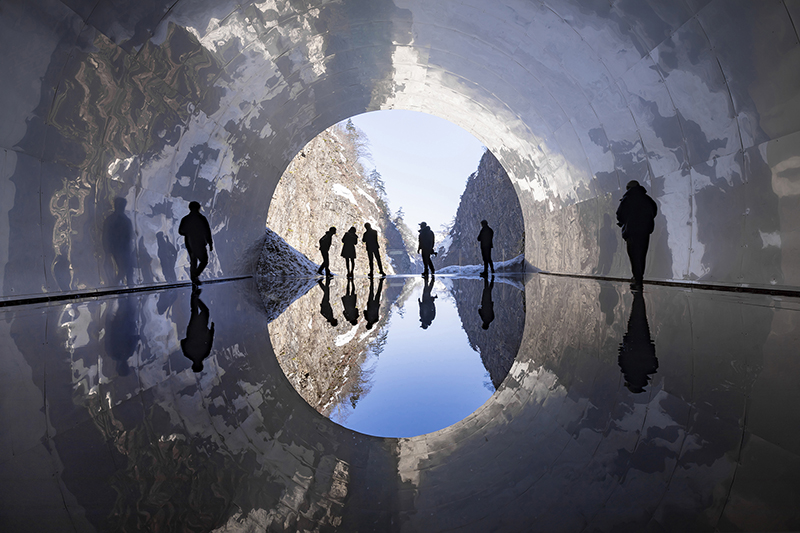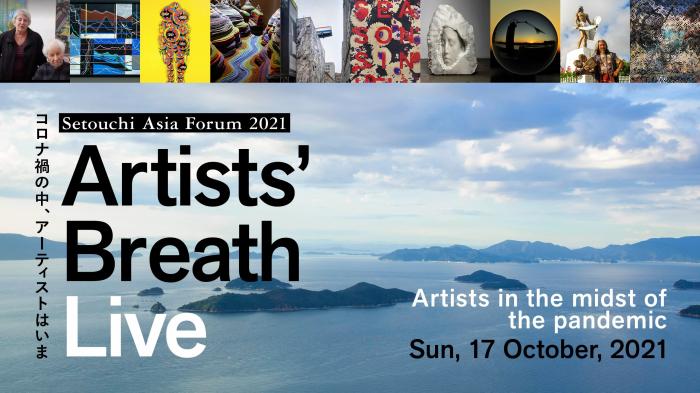TOPICFRAM KITAGAWA2022.02.22
Message from Fram Kitagawa: The Need for Art Today, in the Midst of Our Changing World

photo by Osamu Nakamura
In the Third Year of the Pandemic
While almost two months have passed since the start of 2022, Japan still finds itself in the midst of the Covid-19 pandemic. For the past two years, various projects that we are involved in including art festivals in particular, have been in a difficult situation. Last year, three art festivals that had been postponed from the previous year were realized under strict health and safety measures, and this year, we are preparing to hold two major art festivals, the Setouchi Triennale and the Echigo-Tsumari Art Triennale, which was postponed from last year.
The Okunoto Triennale was originally scheduled for fall 2020, but had been postponed for a year. However, during that one-year period we implemented the Okura Zarae project to thoroughly unearth and collect various resources that have been stowed away in the homes of local people for generations, the results of which took shape as the Suzu Theater Museum. The vacant houses, closed schools, former nurseries, and abandoned railway tracks and empty platforms where the artworks were presented, could perhaps be regarded as “satellite spaces” of the theater museum.
The Northern Alps Art Festival had also been postponed for almost a year from its originally scheduled date of early summer 2020. The art festival, unlike it’s first installment that was set against the backdrop of the cool and clear nature of the Northern Alps, had taken place in the season of ever-changing rich autumn foliage, encouraging visitors to discover the new charm and appeal of the region.
The Boso Satoyama Art Festival: Ichihara Art x Mix 2020+, which was scheduled to open in March 2020, was postponed twice in line with increasing effects of the pandemic. Although the timing of its opening had remained uncertain, the decision was quickly made in mid-October last year to hold it over a shortened period of time to 29days from November 19, giving rise to an art festival that brought to light the various appeal of the region and community while actively making use of the local railway that is at risk of being discontinued.
The three art festivals were each implemented with various measures set in place to prevent the spread of infection, and all had managed to fulfill their duration without any cases of infected persons. However, none of them were able to prepare any tours or food-related programs that they had continued to put efforts into thus far. In addition, although there were some that involved the local community, most works could not be produced in collaboration with people including various supporters from the outside. While overseas artists had visited Japan for site visits, almost all production and installation had to be done remotely. Some of the performances were not realized, as it had not been possible to postpone them due to reasons of schedule adjustment and customer attraction. Difficult circumstances continued, with some being presented in the form of video screenings instead.
Although the Echigo-Tsumari Art Triennale had been postponed, two of its major hub facilities underwent renewal and were both opened in the summer last year. The former Echigo-Tsumari Satoyama Museum of Contemporary Art, KINARE was renovated into The Museum on Echigo-Tsumari (MonET) with strengthened museum functions, and renewal efforts were also progressively underway for the Matsudai Nohbutai centering on its archive of works by Ilya & Emilia Kabakov. Based on the concept “Echigo-Tsumari this year,” I feel that we have taken a big step toward sustainable operations that optimally makes use of permanent facilities and existing works.
Art that Connects People, Nature, and the World
I am grateful that many people have actually visited and taken part in these community-based art festivals, and I am also pleased that people from a different demographic have started to appreciate and find value in such endeavors. With the pandemic having placed restrictions on movements and gatherings, I feel that society’s interest and expectations for art as a whole have become even stronger than ever before. This is in part due to the re-questioning of our heavily urban-oriented civilization in response to the global environmental crisis and impacts of climate change, and a growing awareness towards the countryside and rural areas. At the turning point of such an era, I have come to realize what it is that in fact attracts people to art. That is, art’s ability as a mediator that serves to facilitate connections between people and people, people and places, or people and nature, as well as its almost “child-like” amusingness due to its very frailty, cumbersomeness, and need for care and attentiveness. Furthermore, that which also plays a significant part is the power of artists to “dream and imagine.”
The Setouchi Asia Forum 2021 –Artist’s Breath that took place online in October last year in an effort to connect people from around the world, is indeed a testimony of this. “Artists’ Breath” was an Instagram project launched between June 2020 and January 2021, in which we asked 200 or so artists with whom we have connections with to each post a two-minute video sharing what they have thought about and have been doing during this unprecedented pandemic that we as a world are all experiencing in this very same moment.

At Artist’s Breath Live, held nine months later, 31 artists from 27 different countries and regions took part, each giving a three-minute live report on where they are and what they are doing. Over 1,000 worldwide had watched the event, which was live-streamed online. The booklet that was released in correspondence to the event features a compilation of written texts contributed by 77 artists from 39 different countries and regions around the world, and gives an account on their experiences and contemplations over the past two years. What is written in their text is highly personal, yet when reading through them one realizes that they contain a universal message to humanity, enabling readers to capture a glimpse something of the true essence of art, which differs to art that has sharpened its response to the market. From global environmental problems, the limits brought about by financial capitalism, the persistence of colonialism, the disparity between social inequality and human beings, to homogeneous urban society, many significant issues are present within contemporary society. As such, there is a serious consideration for what artists can do in this society that we live in.
As one of the 7.8 billion people living on earth, I wish to pay close attention and listen to the words and thoughts of artists. I feel that there is no time than now in this very moment that their ideas and works provide us with hope. The growing anticipation and interest in art festivals is but a part of this large and dynamic current.
Community-Based Art Festivals Attracting the Attention of Businesses and the World Bank
Similar tendencies can be seen for businesses. In November 2020, KEIDANREN (Japanese Business Federation) proposed, “Regional Revitalization in the with/post COVID-19 Era –Generating a Flow of People from the Tokyo Area to Local Regions.” In November 2021, the “Regional Co-creation Action Program” was announced with aims towards regional revitalization. My belief is that “Regional Revitalization” is the most important area in Keidanren’s “New Growth Strategy.” I considered regional revitalization through art and culture as an important theme in order to promote the co-creation of value in local regions while making the best use of its distinct features and characteristics. I subsequently gained the opportunity to give a lecture at the Keidanren Regional Economic Revitalization Committee together with the Mayor of Tokamachi, due to the Echigo-Tsumari Art Triennale being selected as one of the collaborators for the various companies, universities, local governments, organizations, etc. that Keidanren supports in their efforts towards regional co-creation.
People working at the front lines of various companies had also visited the art festivals.
In Suzu, Omachi, and Ichihara, where art festivals were held last year, I often saw people from companies and local governments going around viewing the works. Rather than as an act of patronage or social contribution, companies are beginning to move towards the community and art as part of their main line of business.
This movement is seen not only in Japan and other developed countries, but is also spreading to developing countries. To promote sustainable development and inclusive growth, the World Bank emphasized the utilization of culture and creativity in place of prior development support centered on hardware, and proposed regional economic development leveraging art festivals. The World Bank has been conducting research towards the realization of an art festival in Sri Lanka, which is set to be a pilot project. Although I was attempting to create a model for adapting the methods of the Echigo-Tsumari Art Triennale to developing countries by investigating local resources such as nature, tourist spots, plazas, local products, closed schools, and vacant houses, my research was suspended due to the effects of the pandemic. Yet now again, art festivals are receiving increasingly significant attention as one of the leading approaches to socio-economic recovery from the pandemic, and research is about to resume. As part of the World Bank’s “Climate, Culture and Creativity Event Series,” an online forum titled “Achieving Local Economic Development Leveraging Art Festivals” will be held on March 2, where I will presented a keynote lecture.
As for Art Front Gallery as a whole, we wish to develop activities in response to the various movements and trends of our world that is currently on the verge of a changing phase. Not only in the context of art festivals, but also in the construction and redevelopment projects for hotels, office buildings, and homes, rather than simply providing art, we want to create works that are both regional but also harbor a sense of internationality. We sincerely hope to collaborate with companies, local governments, institutions, and various people who are looking for art that is not just eye-catching, but has the potential to generate further value and meaning, and serves as a medium for engaging with the region and community.
Fram Kitagawa
Chairman, Art Front Gallery
(translated by Kei Benger)
UPCOMING

TOPIC
4/23(火) 北川フラム塾 第30回 地方芸術祭と震災-奥能登を中心に(ゲスト:暮沢剛巳)
Exhibition
Oscar Oiwa solo exhibition:Oil Octopus in the era of turbulent at Shibuya Hikarie 8/,Apr.27-May.12
TOPIC
Uchiboso Art Festival will be held from March 23rd.
TOPIC
The Oku-Noto-Suzu Yassar Project has been launched.
TOPIC
Art Festivals and Exhibitions 2024